
How Interconnects Work: Characteristic Impedance and Reflections
Digital interconnects are modeled as transmission lines defined by characteristic impedance and propagation constant. This article explains how transmission lines work and provides practical formulas for investigation of signal degradation due to absorption and reflections losses. Optimal characteristic impedance is defined for printed circuit board (PCB) and packaging interconnects as the impedance that minimizes the power absorbed by interconnects and terminators. It is shown that 50 Ω single-ended or 100 Ω differential may be not optimal if we need either longer reach or spend less energy per bit transmitted over interconnects.

Where I is the current, V is voltage changing along the x-axis, f is frequency (Hz). Z(Ω/m) is complex impedance per unit length and Y (S/m) is complex admittance per unit length, R(Ω /m) and L (Hn/m) — are real frequency-dependent resistance and inductance per unit length, G (S/m) and C (F/m) — are real frequency-dependent conductance and capacitance per unit length. Z, Y, R, L, G, and C for N+1 conductor problem or N-mode transmission line are NxN matrices in general. They are 2×2 matrices for a three-conductor differential line for instance. The impedance and admittance per unit length are frequency-dependent, in general, and are completely defined by transmission line type and cross-section and usually computed either with a static or quasi-static 2D field solver or sometimes with 3D EM solvers. Note that the use of 3D solvers does not automatically guarantee higher accuracy.
A solution of the Telegrapher’s equation can be written as a superposition of two waves propagating in opposite directions as follows (can be easily verified by inspection):
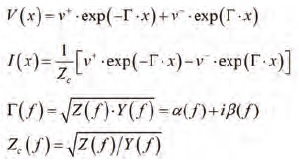
Where Zc is complex frequency-dependent characteristic impedance and gamma is complex propagation constant ( is the attenuation constant (Np/m) and beta is the phase constant (rad/m) defined as
is the attenuation constant (Np/m) and beta is the phase constant (rad/m) defined as  Lambda is the wavelength in the transmission line — phase changes by
Lambda is the wavelength in the transmission line — phase changes by  over that length, see more in the Appendix). Those are the modal parameters in general — the equations above are for a two-conductor line with one mode only. If we write the solution for the wave propagating only in one direction along the x-axis for instance (would be ideal for signal transmission):
over that length, see more in the Appendix). Those are the modal parameters in general — the equations above are for a two-conductor line with one mode only. If we write the solution for the wave propagating only in one direction along the x-axis for instance (would be ideal for signal transmission):
We can see that the characteristic impedance is just a ratio of the voltage and current of the wave propagating in one direction of transmission line v(x)/i(x)=Zc. It is impedance by dimension (Ω). It is pure resistance if line is lossless. The word “characteristic” is used because it does not depend on the position or length of transmission line segment (independent of x) — it “characterizes” it. It depends only on the type of transmission line and geometry of the cross-section. Note that for planar transmission lines, used for PCB and packaging interconnects, the definition of impedance is not unique and can be done in three ways — through voltage and current, current and power, and voltage and power, but they all close to the conventional “static” voltagecurrent definition if cross-section remains much smaller than the wavelength, which is usually good assumption for PCB and packaging interconnects.
To investigate the reflections, the next step is to define the properties of a transmission line segment. The Telegrapher’s equations introduced in the previous section are incomplete without the “boundary conditions” or terminations. The most effective way to describe a segment is to use waves and scattering parameters (Sparameters). Here is a transmission line segment with length l connected to voltage sources with all variables, to define S-parameters:

Where a1, a2 are the “incident waves,” and b1, b2 are the “reflected waves” with dimension sqrt (Wt). V1, V2 and I1, I2 are voltages and currents at the segment ports (pairs of terminals). Z0 is the termination or normalization impedance (same thing in this context). Waves in this definition are not actual waves in the transmission line, but rather variables formally defined through voltage and current. Using equations for voltage and current in the transmission line segment (superposition of two waves defined earlier) and Kirchhoff’s laws at the external terminals or by following more formal procedure from “S-parameters for Signal Integrity,”4 we can define S-parameters or S-matrix that relates the incident and reflected waves for such segment as follows:
 The reflection (S11 and S22) and transmission (S12 and S21) can be expressed separately as follows:
The reflection (S11 and S22) and transmission (S12 and S21) can be expressed separately as follows:
 Note that the transmission parameters include the effects of absorption and reflections — there are no approximations in these expressions. This is a universal definition of the reflection and transmission — it can be used for simple experiments with transmission line properties or as rigorous modelling of a segment. It depends on the definition of characteristic impedance and propagation constant used. The rest is pure trigonometry. You can start with a frequency-independent capacitance and inductance per unit length or use more complicated expressions for the characteristic impedance and propagation constant.5 For simple experiments, the propagation constant can be defined analytically with formulas or simply with phase delay or propagation velocity for ideal lines (see Appendix). This is a simple and important tool for all kinds of experiments in the frequency domain with real transmission lines. It includes all reflections in time domain (if model bandwidth is properly defined).1 Though, use of frequency domain response for time domain analysis is not as easy.4 Simbeor software is used here for all frequency and time domain analyses — it makes our investigation easier.
Note that the transmission parameters include the effects of absorption and reflections — there are no approximations in these expressions. This is a universal definition of the reflection and transmission — it can be used for simple experiments with transmission line properties or as rigorous modelling of a segment. It depends on the definition of characteristic impedance and propagation constant used. The rest is pure trigonometry. You can start with a frequency-independent capacitance and inductance per unit length or use more complicated expressions for the characteristic impedance and propagation constant.5 For simple experiments, the propagation constant can be defined analytically with formulas or simply with phase delay or propagation velocity for ideal lines (see Appendix). This is a simple and important tool for all kinds of experiments in the frequency domain with real transmission lines. It includes all reflections in time domain (if model bandwidth is properly defined).1 Though, use of frequency domain response for time domain analysis is not as easy.4 Simbeor software is used here for all frequency and time domain analyses — it makes our investigation easier.
Now, what useful information can be derived from such a simple trigonometric model? Let’s begin from a very simple case of the termination or normalization impedance equal to the characteristic impedance Zo=Zc — the reflection parameter is zero in this case as we can see from the formula. The S-matrix in this case is simple and defined as follows (generalized modal S-parameters):

Only the transmission parameters and no reflections — this should be the Holy Grail of the interconnect design — the signal is travelling strictly in one direction. Though, the signal may still not get through because the transmission parameter depends on the absorption and dispersion in Gamma discussed earlier.2 Considering the zero-reflection condition, why do we not do it like that way? First, the characteristic impedance is complex for lossy lines — it has real and imaginary parts. The zero-reflection termination is not just a resistor — it should be frequency dependent. But this is not the showstopper— the real part of the characteristic impedance does not change much at the important frequencies and the imaginary part is much smaller than the real part, as can be seen in Figure 1 (typical PCB case).
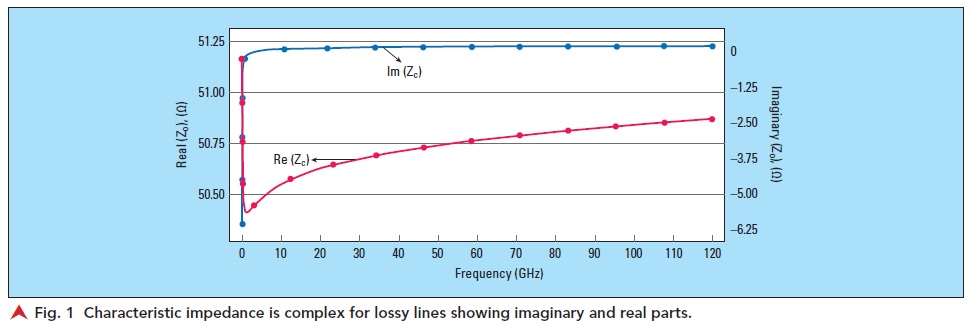
So, at least theoretically, we should be able to get very close to the non-reflective case. Practically, there are more factors that do not allow this to happen — the manufacturing variations and discontinuities such as pads and viaholes are the most important ones.
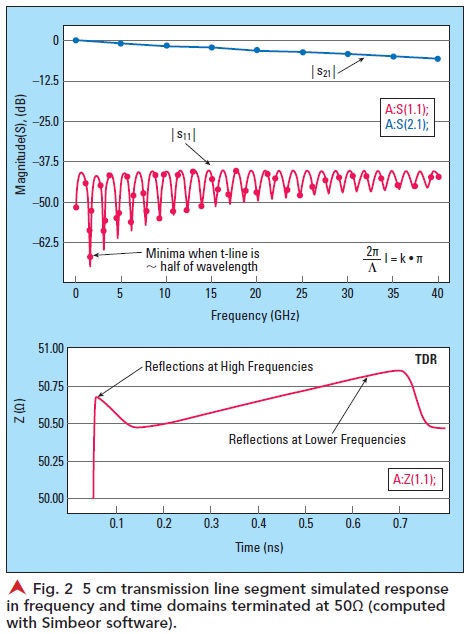
What if the characteristic impedance of the transmission line is significantly different from the termination impedance? Let’s take a look at a 25 Ω stripline in the same stackup as before, shown in Figure 3.

Magnitudes of the transmission (insertion loss) and reflection in dB are shown on the top plot and TDR on the bottom. The reflection went up considerably, that means more signal energy is reflected. As the result, the transmission or insertion losses went down at some frequencies — less signal energy is transmitted. The insertion loss now is wavy and repeats the reflection pattern — maxima in the reflection are the minima in the insertion losses. The signal energy here is either reflected or absorbed. The top plot also has the expression for the reflection parameter — the hyperbolic tangent in the denominator explains the minima and maxima—it is trigonometry, though with the complex numbers. S-parameters are used directly to compute the TDR that shows some multiple reflections from the ends of the segment in this case.
Another case with considerably larger characteristic impedance about 75 Ω (cannot be exact) and same segment length and 50 Ω terminations is shown in Figure 4. The S-parameter plot looks very similar to the previous 25 Ω case. Though, it has more conductive losses and the TDR goes up, instead of down, and shows more resistance (slope up) in the narrow transmission line as expected. In both “reflective” cases only one or two reflections are significant – it disappears quickly due to the absorption losses (losses are our friend in such reflective cases).

Optimal Characteristic Impedance
of an air-filled coaxial transmission line between the maximal transmitted power and minimal losses.7 Indeed, a coaxial line always has a minimum in losses vs. impedance. Though it is dependent on the dielectric fill, but it happens to be close to 50 Ω for coaxial lines filled with PFTE-type dielectric with Dk close to 2.7 As we know, striplines are the descendants of the coaxial transmission lines, but the stripline losses do not have minimum on the loss versus impedance function. Here is the attenuation in dB/m for a stripline modeled with Dk=3.5, LT = 0.002 at 1.0e9, Huray-Braken roughness model: SR = 0.1 μm, RF = 9 as a function of dielectric thickness and characteristic impedance at 10 GHz, shown in Figure 5.
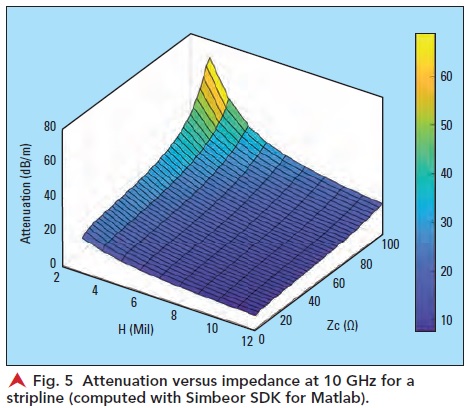
The attenuation is lower for the lower characteristic impedance (Zc axis) as well as for the thicker dielectrics (H axis). The conductor losses dominate in striplines with very low loss dielectrics.2 It means that the crosssections with more metal and lower impedance have smaller losses in general. Though, the single mode propagation condition and layout density may put additional bounds on the increase of the cross-section size and on the lowest impedance as well. So, is the lower impedance always better? Not really, if our goal is to minimize the power absorbed by the interconnects and terminators. For instance, if we need 0.1 V signal at the receiver and compute power required at the transmitter side (Pin=20log(Vout)-10log(|Zc|)+Att_dB*Length, dBW), we will see some minima (same example as above at 10 GHz) as shown in Figure 6.

The minimal power depends on the geometry (dielectric thickness H above and below trace and trace width adjusted to have an impedance value on the x-axis) and also on length (plots are for a 1 m segment). Lower impedance should be considered for thinner dielectric layers. Strip widths in this example are set to have the impedance shown on the x-axis (Simbeor SDK used for computations). Terminations in this case were set equal GHz (no reflections). As we can see, the lower characteristic impedance is not always better and may be optimized for a particular system.
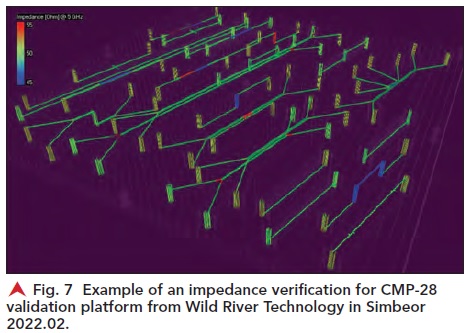
The green color is used for objects with the impedance close to the target impedance (50 Ω
single-ended or 100 Ω
differential). Objects with the impedance below the target are blue and with higher impedances are red. This is a well designed board with a small number of intentional impedance violations in some structures. Also, it comes from Wild River Technology with the measurements up to 50 GHz for validation purposes. Simbeor evaluates the input impedance of the vias with fast EM models of multi-vias (signal + stitching vias) and impedance of traces with Simbeor SFS 2D field solver at the Nyquist frequency.
Another example of how the reference conductors can change the impedance of traces on a design with traces going through BGA breakouts is shown in Figure 8. Here Simbeor evaluated effect of the cut-outs and reference pads on the impedance—those cannot be avoided. We can see that the impedance of connector and AC coupling pads is below the target and the impedance of the length compensation sections are above the target (layout mistake). The discontinuities in the reference conductors also create impedance violations (another layout mistake). Though, most of those violations may not kill the signal and are important at relatively high data rates.
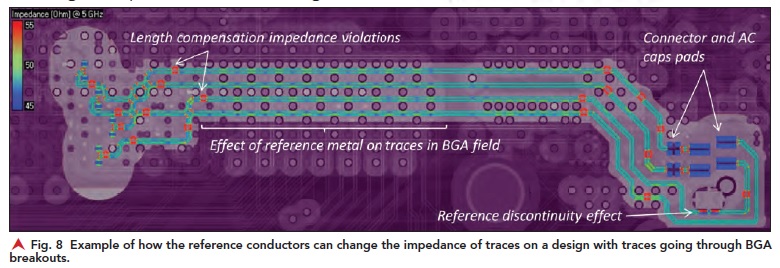
7. “Why Fifty Ohms?,” Microwaves 101, Web: https://www.microwaves101.com/encyclopedias/why-fi fty-ohms.

